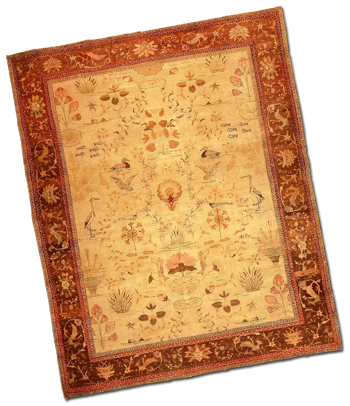 Is There Really Silk in My Persian and Oriental Rugs? Sedona AZ
Is There Really Silk in My Persian and Oriental Rugs? Sedona AZ
After spending quite a bit of money on an area rug that you have spent quite a long time hunting down, you’ve got what you think is a rug with a silk fiber in it. Why else would it have cost so much? After all, silk is such a high end fiber that it’s highly sought after and the cost is justifiable. A fine, soft, and shiny fiber, silk is attractive to not only you, but master rug weavers as well. The natural properties of silk allow weavers to create masterpiece rugs with tiny, intricate, and beautiful designs that have a lot of detail in them. In fact, it isn’t unusual to find as many as 900 knots per square inch in a silk rug (yep, you read that right!)
If you’d like to guestimate how many knots per square inch you have in your rug, turn it over and lay a ruler down on the back. Count the knots from left to right in a 1” area and then count the number of rows going up and down in a 1” section as well. Let’s say you counted 90 knots across and 10 rows down – by multiplying these two numbers, you come up with 900 knots per square inch. Now, this is going to be difficult because the knots will be extremely fine and tiny, but at least you’ll have a good idea of how many knots are in your rug! A very fine area rug with an extremely high knot count such as this will certainly be silk. It will also cost thousands and thousands of dollars and will be found in a fine rug gallery. Folks who have silk rugs KNOW it because they have invested a substantial amount of money in such high quality rugs.
Like I said earlier, silk is very desirable in the consumer market. Which is why manufacturers have attempted to copy silk’s look by producing alternative fibers. Many of these fibers are created from an inexpensive blend of various fibers that have been chemically treated to give the look of silk. These fibers are then given names that sound a lot like silk, which fools not only the consumer but also sometimes the sales person.
Pay attention to what fiber names are listed on the label of your rug. If you see names like Art Silk, Faux Silk, Bamboo Silk, Coconut Silk, Banana Silk, Flax Silk, Hemp Silk, Raw Silk, Rayon, or the always popular Mercerized Cotton, then you do NOT have real silk. These fibers do not perform like real silk because of the way that they are manufactured. Faux silk fibers do not stand up to the wear and tear of the life of rugs and can often “ugly out” sooner than a normal area rug would.
Migration of colors is very likely with these rugs because they are often not color fast. This presents cleaning challenges for even experienced rug washers. Don’t fret, though, because the cleaning technicians at Arizona Oriental & Specialty Rug Care in Prescott will work their hardest to control and minimize these cleaning challenges. Stains are most often permanent on faux silk rugs, so be aware that while we try our best and work our hardest to achieve the best cleaning results possible for your rug, some things are not removable.
Till next time, enjoy your beautiful art for your floor and remember a clean rug is a rug that can last you a lifetime!
Arizona Oriental & Specialty Rug Care serves Sedona, Prescott, Prescott Valley, and much of the Northern Arizona areas. We meet the highest standards in professional cleaning of area rugs with rug wash specialists having earned the highest training which includes certification as WOOLSAFE FIBRE CARE SPECIALISTS through the WOOLSAFE ORGANISATION. Such extraordinary certification ensures the area rugs of our client’s receive the utmost in care.
If you’d like more information how to tell if your rug is really silk or a quote to clean your rug at 928-445-1718, visit our website at www.ArizonaOriental.com, or stop by Monday through Friday 10:00 am to 5:00 pm at our rug washing facility at 565 EZ Street, Prescott, AZ 86301 (pick-up and delivery also available).




